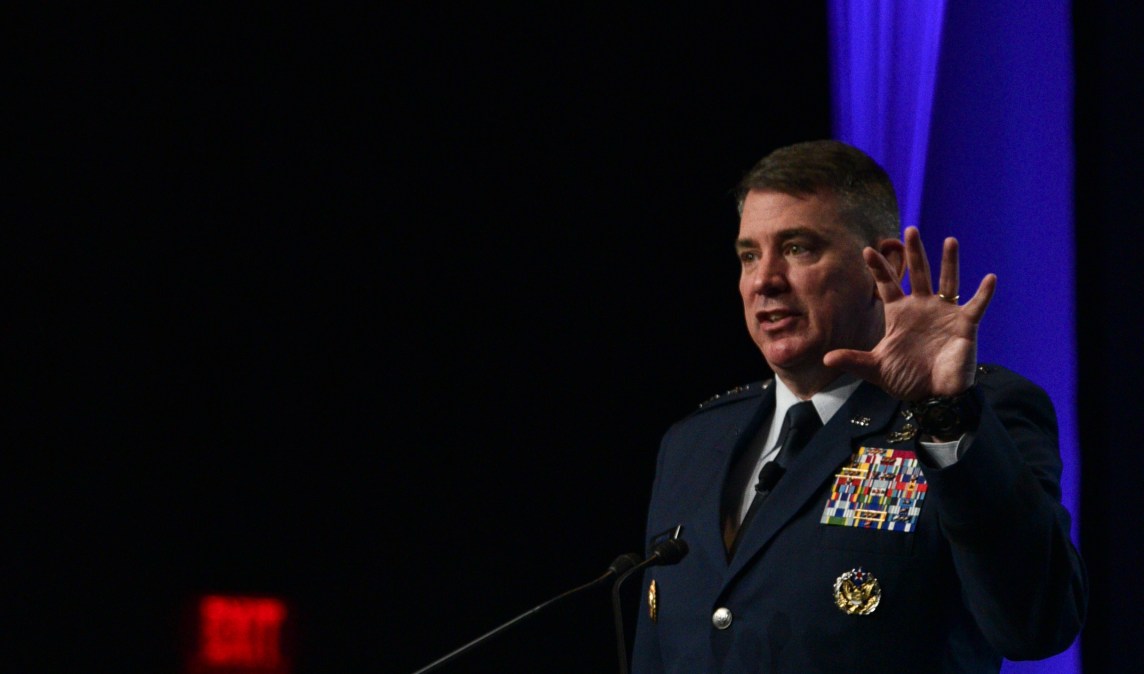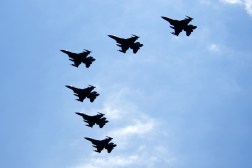Air Force information warfare strategy seeks to beat back adversaries that have been ‘operating in with impunity’

For too long, America’s competitors have been largely unchallenged below the threshold of armed conflict. The Air Force, for its part, recognized this and sought to address it directly in a new strategy.
“One of the main reasons we started looking at that is, this has been territory that our adversaries have been operating in with impunity lately,” Maj. Gen. Daniel Simpson, assistant deputy chief of staff for intelligence, surveillance and reconnaissance, A2/6, told DefenseScoop in a recent interview. “That blurring of competition, crisis and conflict … they’re operating in an area that’s below that threshold of armed conflict. Russia and China are doing this right now and not only are they doing it, they’re combining it with traditional military activities and trying to do it with impunity because there’s been no ramifications.”
Last summer, the Air Force created an information warfare (IW) strategy and in December, it finalized an implementation plan. However, both are classified and thus out of public view.
“What the Air Force IW strategy does, it gives us a path to advance our own IW capabilities in order to try and gain and then maintain, preserve our dominance,” Simpson said. “What we’re looking at … is critical resource and investment decisions to be able to organize, train and equip scalable, cross-discipline and integrated IW capabilities to get convergence or synergistic effect between those capabilities.”
Simpson said the classification is necessary because the strategy, and more so the implementation plan, get into specifics regarding organizing the force, modernizing infrastructure and utilizing cross-cutting tools and capabilities.
He also clarified that this is the Air Force’s information warfare strategy, and not that of the entire Department of Air Force, which also includes the Space Force.
Simpson explained that the proliferation of information technology has forced a paradigm shift essentially. The logic of war has sought to alter human behavior by imposing one’s will on leaders and the general population. That traditionally had been done through physical force. However, IT now provides the opportunity to instantly deliver tailored effects not just to populations, but also at the individual level, which is a significant change.
“It’s not a population that makes decisions. It’s an individual; and what do we know about the individual?” he said, adding that “the level of detail that you need to know your potential adversary or your target audience, the level of fidelity that you need now is much, much greater.”
“That individual may be an iron worker that lives in a city, that individual may be a national leader, that individual may be a battalion commander that is coordinating attacks in Bakhmut against Ukrainians,” Simpson said. “Those are the types of audience that you would like … to conduct influence operations against, but the level of intelligence you need to be able to shake that is much greater than you would need or you had needed in the past.”
Fundamentally, information warfare capabilities underwrite all of the Air Force’s core functions, Simpson said, referring to air superiority; intelligence, surveillance and reconnaissance (ISR); rapid global mobility; global strike; and command and control.
Since there is no joint definition for information warfare, the Air Force made the decision to place five functional areas under the IW umbrella: ISR, cyber effects operations, electromagnetic spectrum operations, influence operations and public affairs.
Over the past few years, the services, in one form or another, have sought to address information warfare in their own way, issuing strategies and their own lexicons based on how they fight.
Simpson said the Air Force did coordinate with the other services when crafting its own strategy to get as much broad guidance as it could, given the Air Force must fight as part of the joint force under a four-star combatant command. There was agreement in some areas and disagreement in others with the sister services, he explained.
To succeed in a future conflict, the Air Force and the greater military must adapt to changing tactics and modern approaches, Simpson said.
“I like how one of the folks on our team put it: If we fail to adapt and we hope to win with capabilities and tactics from the last war, then we are destined to defeat,” Simpson said. “If we do this right, and we get it right, we have an integrated employment of those IW capabilities … we’re going to have unmatched domain awareness with an information advantage to be able to drive that in the future.”
At the operational level, this has culminated with the foundation of the 16th Air Force, the service’s first information warfare entity. Created in 2019, it combined the Air Force’s ISR and cyber units into an integrated formation that Simpson called the “competition force of choice right now because of the capabilities that they present.”
With a single commander overseeing all aspects of information warfare, Simpson said the force is realizing synergies they didn’t know were possible previously.
“One of the huge benefits is seeing opportunities that we didn’t know really existed before and then under one commander being able to quickly go, ‘Hey, I’ve got an authority shortfall in this area in being able to get after those,’” he said. “This organizational structure helps present forces in a way to be able to try and execute much more quickly, and then removing some of those barriers that have slowed us down.”
Developing information operations professionals
The Air Force has been working to integrate its cadre of information operations personnel more broadly across the force.
The 14F work role was developed for information operations officers. The deputy chief of staff for operations, or A3, technically owns the 14F as the functional authority, and the A2/6 loaned them a senior executive service civilian to be the functional manager for the information operations career field to lead developmental teams and do the talent management. That official is Elizabeth Chamberlain, associate director for cyberspace operations and warfighter communications, within the A2/A6.
While this is a small career field — officials in the past said it will only have around 500 or so personnel and Simpson said that hasn’t grown — it is having an impact already.
Simpson provided a couple of examples of how they’ve contributed to operations. In the first, 14F personnel examined how the Air Force was executing B-2 bomber operations to see how they could deceive adversaries to modify the true destination of the aircraft disrupting that nation’s intelligence against where the B-2 was going.
In another example, 14Fs along with U.S. Air Forces in Europe and European Command used exquisite intelligence developed messages about Russia’s military build-up ahead of its invasion of Ukraine last year and publicly discredited Russia’s narrative that it wasn’t planning anything.
“I’d say that actually had a pretty good effect, because look where Russia is now compared to where Russia was there when it comes to world opinion,” Simpson said, adding that it’s possible with more successes like these in the future to grow demand signal.






